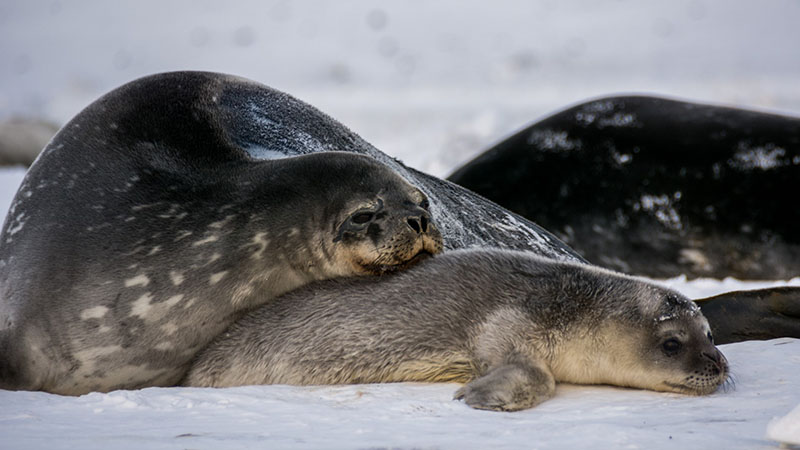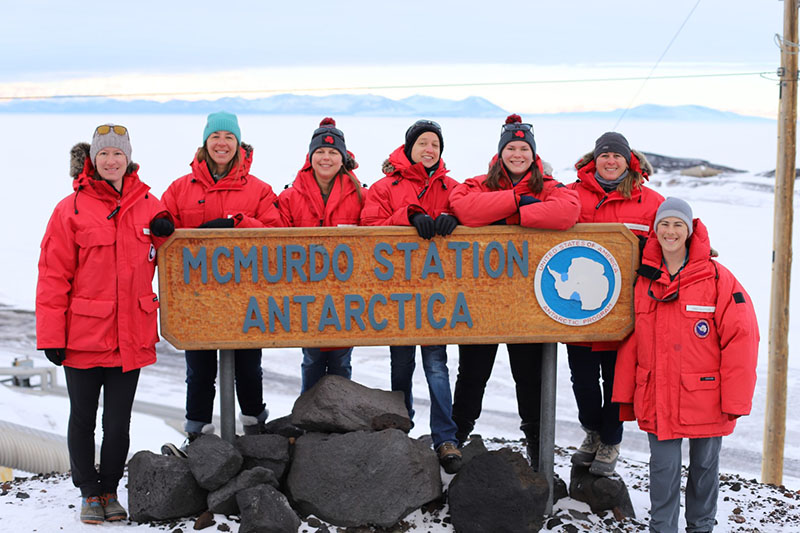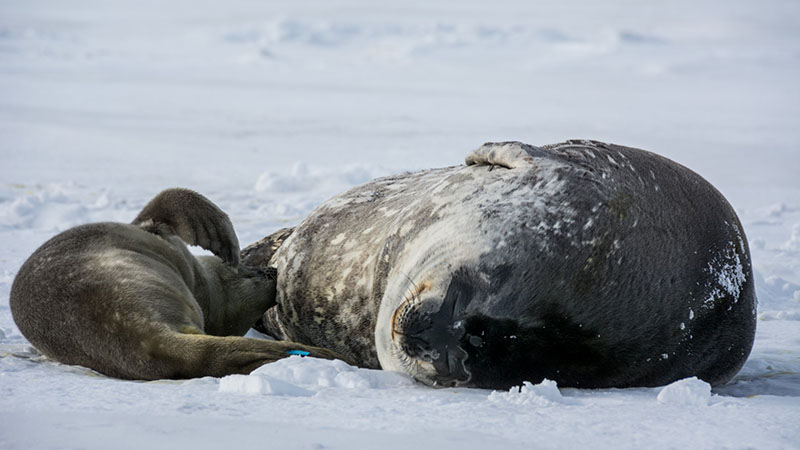A Seal Grows in AntarcticaLearning How Weddell Seals MaturePosted April 1, 2020
Weddell seals thrive in some of the coldest conditions on the planet, but scientists aren't quite sure why they don't freeze when they're first starting out. 
Photo Credit: Mike Lucibella
When baby seals are first born, they're covered in soft, fluffy fuzz called lanugo fur to help keep them warm. NMFS Permit 21158.
This year an all-female field team finished collecting data about how baby seals successfully grow up to be the southernmost mammals in the world. "We're looking at the early development of Weddell seal pups, mostly during the time that they're with their mom and as they transition to being independent seals," said Heather Liwanag, a physiologist at California Polytechnic State University and principal investigator on the project. She added her team was looking at "how these little guys stay warm in Antarctica and how they develop their ability to dive because Weddell seals are known to be champion divers but they don't start out that way." They're curious, because Weddell seal pups seem to lack a number of adaptations that seals living in the Arctic have developed to stay warm. This was the second field season they spent looking at what strategies they use to survive in the harsh Antarctic conditions. "They start out as basically a little bag of fur that lives on the ice, and somehow is able to be warm and perfectly happy out there without all the body size and blubber thickness of the adults," said Linnea Pearson, a post-doc at Cal Poly and co-Principal Investigator on the project. "We're trying to figure out how do they stay warm and how do they develop diving abilities, how do they become a 'real seal,' and transition from a little terrestrial animal into a deep diver." The project is supported by the National Science Foundation, which manages the U.S. Antarctic Program. Keeping WarmWeddell seal pups present a kind of mystery to researchers because it's hard to tell just how they're staying warm as the southernmost mammal. "For keeping warm, what we have to compare them to is primarily the Arctic seals," Liwanag said. "There are a couple of different strategies that are known for Arctic seals." 
Photo Credit: Mike Lucibella
A mom and her pup bond in a seal colony at Big Razorback island, near McMurdo Station. NMFS Permit 21158.
Many seal pups, including Weddell seals, are born with a special kind of fluffy, heat-trapping fur called lanugo fur that they shed within the first few months of life. Other seal species have additional adaptations that help keep their pups warm. Some are born with a special kind of fat called brown fat that generates heat. Other species of seals are born with a thick blubber layer and develop quickly. "Weddell seals don't have either of those strategies. They're clearly making it work because they're doing fine," Liwanag said. "What is it, besides lanugo, that's keeping them warm?" It's not only their ability to stay warm while on top of the sea ice; the team is looking to understand how young seals maintain their body temperatures in the frigid Southern Ocean. Adults can hold their breath and stay submerged in waters as cold as minus 1.8 degrees Celsius for up to an hour and a half. However, it takes time for them to build up to being comfortable in seas that cold. "What we're curious about is when they're ready to get into the water. So what we're doing is comparing their metabolism in air to their metabolism in water, and if it's the same then it's not costing them any energy to be in the water, it's not too cold for them," Liwanag said. "We're looking at when that happens, where they go from being colder in the water to actually being totally fine in the water." Working with WeddellsWeddell seals have been a favorite for researchers to study for a number of years. On the one hand, there's detailed population data on them because scientists have been keeping close track on their population numbers around McMurdo Sound for more than fifty years. In addition, the animals themselves are easy to work with. "They're a really interesting species because they don't have predators at their breeding site," said Emily Whitmer, a veterinarian from the Marine Mammal Center. "They don't have an evolutionary pressure to be concerned about predators where they're breeding." Though an experienced veterinarian and an expert on a range of different seals and other marine mammals, it was Whitmer's first time working with these particular pinnipeds. 
Photo Credit: Mike Lucibella
A Weddell seal contemplates jumping into the cold Antarctic water. Liwanag and her team are studying how young seals are able to stay warm in the freezing waters. NMFS Permit 21006.
"I did not expect how calm they were," Whitmer said. "I work with all kinds of wild species that don't like humans and you're spending all of your time working with them protecting yourself. And these animals are so placid. It's incredible." Not only are the animals docile, but they're also relatively easy for researchers to reach. Every year, expecting mothers return to colonies near the National Science Foundation's McMurdo Station and haul out onto the sea ice to give birth. Known as "fast ice," this layer of frozen ocean is several feet thick. It can support scientists driving snowmobiles and other vehicles to reach these seal colonies, giving these researchers unprecedented access to these animals. "You don't often get to track the same animal throughout its early development," Pearson said. "These Weddell seals are nice for that because they're very reliable. They don't really go anywhere and we can get to them reliably." Liwanag thinks that living with this solid ceiling of sea ice over where they swim may have influenced their evolutionary development. Weddell seals are adept divers, able to hold their breath and stay submerged for more than eighty minutes. "Many other seals, even the Arctic ones, they live in pack ice, so finding a breathing hole is not a problem because it's floating ice floes and there is always open water. [Weddell seals] are under the fast ice, and so finding an open breathing hole is actually a challenge," Liwanag said. "They have to have really tight regulation on their physiology… in order to manage that and hold their breath long enough to find a breathing hole after these long dives that they're doing." Though their physiology differs in some ways from Arctic seals, there's much that the Weddell seals can teach researchers about their cousins on the far side of the globe. "Arctic seals are struggling with climate change. Antarctica is reacting differently but also in a lot of the ways the same," Liwanag said. "They're a good measure for what that means for the ecosystem as a whole. They're very dependent on the ice for their pups being able to be born away from predators, and this is where they find their food and where they try not to be food and if that environment is changing, we're going to see that when we study what is happening to them." Challenging SeasonWorking in Antarctica is never easy, but this season Mother Nature threw the researchers a curveball. Over the past winter, a series of warm temperatures and storms kept the sea ice from setting in as thick as it typically does. When they first arrived in mid-September, it wasn't clear that it would be able to support them for long enough to complete their work. "The sea ice was really the biggest challenge this year for us," Liwanag said. "The sea ice thankfully held longer than expected. That got us to that very last animal that we weren't sure we were going to be able to get to by vehicle." The team had to stay flexible and constantly come up with multiple backup plans. When the ice got too thin to support the heavy, full-sized fish huts that are typically set out in the early part of the season, they switched to using a smaller, lighter weight structure. "They pulled the huts [back into McMurdo Station] early and so the [carpenters] went and set up an alternative structure for us," Liwanag said. "It was definitely a workable solution that got us to the end of the season. Without it, we really wouldn't have been able to do that. So that was huge." Late in their season, small cracks in the sea ice started widening, threatening their ability to reach their worksites safely. One crack in particular proved to be a major obstacle until McMurdo Station's field support team built a footbridge over it. "That bridge was eight feet long and we actually had to stop using it by the last week because the crack was bigger than that," Liwanag said. "Thankfully we got to use it for much longer than we would have otherwise." In the end, they were able to complete their project and collect the data they needed just in time before the ice became too dangerous to work on. "Things definitely melted out sooner this year," Pearson said. "The ice is always different every year so you just kind of work with what you have." A Cohesive TeamTo overcome these challenges, the team spent lots of time planning ahead before going out into the field every day. "We came up with contingency plans. Lots and lots of contingency plans," Pearson said. 
Photo Credit: Mike Lucibella
A young seal pup plays with its flippers on the ice near Turtle Rock. NMFS Permit 21006.
Between having these multiple backup plans, putting in a lot of hard work over their many 12-hour field days and the sea ice staying just firm enough for them to work on, they completed their project successfully. Knowing that their time on the sea ice was short, the six-woman research team made sure to take full advantage of every opportunity to get out into the field and collect the data they needed. When putting together her field team, Liwanag looked for people with a special blend of both technical knowhow and other less-tangible traits that are just as important for working out at remote sites. "Someone who's really good in a clinic, might not be able to translate those skills as well to this kind of situation because the kinds of calls you have to make and the resources you have are very different here," Liwanag said. "When you build these teams you do worry about personality and things like that. We made a point of doing some team building and getting to know each other before we got here because we felt it was really important to have that cohesiveness." Liwanag added also that she didn't plan on having her whole field team be made up of women, but it's not uncommon for her field. "This is the second all-female team that I've been on," Pearson said. "It's just kind of the way that it works out in biology, there's a lot of women." Now that their field research is complete, Liwanag and her team are starting to analyze the wide range of data they collected over their two field seasons. "Everyone on the team has something that they're going to be able to take the lead on when they get home," Liwanag said. NSF-funded research in this story: Heather Liwanag, California Polytechnic State University, Award No. 1543539. |



For USAP Participants |
For The Public |
For Researchers and EducatorsContact UsU.S. National Science FoundationOffice of Polar Programs Geosciences Directorate 2415 Eisenhower Avenue, Suite W7100 Alexandria, VA 22314 Sign up for the NSF Office of Polar Programs newsletter and events. Feedback Form |



